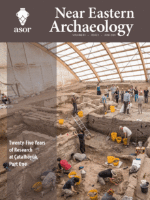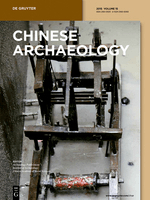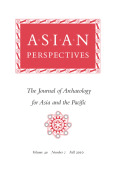
Slovenska Archeologia
Scope & Guideline
Uncovering insights that shape our understanding of the past.
Introduction
Aims and Scopes
- Archaeological Methodologies:
The journal emphasizes various archaeological methodologies, including excavation reports, material analysis, and site surveys, reflecting a comprehensive approach to understanding past human activities. - Cultural-Historical Contexts:
Research often situates findings within broader cultural-historical contexts, exploring interactions between different cultures and periods, particularly in relation to Central Europe and its connections to surrounding regions. - Focus on Material Culture:
There is a strong emphasis on the study of material culture, including artefacts such as pottery, metalwork, and jewellery, which are critical for understanding social structures and cultural practices of past societies. - Interdisciplinary Approaches:
The journal encourages interdisciplinary research that incorporates methods and insights from related fields such as anthropology, history, and environmental studies to enrich archaeological interpretations. - Regional Archaeology:
A key focus is on regional archaeology within Slovakia, documenting local archaeological sites and findings that contribute to the understanding of national and European prehistoric and historic narratives.
Trending and Emerging
- Migration Period Archaeology:
Research on the Migration period has gained prominence, with a focus on cultural exchanges and transitions as evidenced by artefacts and settlement patterns, reflecting broader European dynamics during this time. - Non-destructive Archaeological Methods:
The use of non-destructive methods, such as geophysical surveying and remote sensing, is increasingly highlighted, showcasing a trend towards preserving archaeological sites while still acquiring valuable data. - Urbanism and Settlement Patterns:
There is a growing interest in the study of early urbanism and settlement patterns, particularly in relation to how communities developed in Central Europe, indicating a shift towards understanding social organization. - Interdisciplinary Collaborations:
Emerging themes reflect increased interdisciplinary collaborations, integrating insights from environmental science, anthropology, and technology to enhance archaeological interpretations and methodologies. - Cultural Heritage and Preservation:
A rising focus on cultural heritage, including discussions on preservation and the role of archaeology in contemporary society, illustrates a broader engagement with the implications of archaeological work.
Declining or Waning
- Late Roman Period Studies:
There has been a noticeable decrease in studies specifically dedicated to the Late Roman period, possibly due to a shift towards earlier or more contemporary archaeological periods as researchers seek to fill gaps in knowledge. - Classical Archaeology:
Research pertaining to classical archaeology, particularly studies focused on Greco-Roman influences in Slovakia, appears less frequently, suggesting a waning interest in this specific cultural interaction. - Bioarchaeology:
The exploration of bioarchaeological aspects, such as human remains and health in past populations, is less prominent in recent publications, indicating a potential shift towards artefact-focused studies.
Similar Journals

Yorkshire Archaeological Journal
Illuminating Archaeological Narratives of YorkshireYorkshire Archaeological Journal, published by Routledge Journals, Taylor & Francis Ltd, stands as a pivotal resource in the field of archaeology, particularly focused on the rich heritage and archaeological research within the Yorkshire region of the United Kingdom. With a dedicated ISSN of 0084-4276 and an E-ISSN of 2045-0664, this journal provides both researchers and practitioners valuable insights into archaeological discoveries, methodologies, and theoretical frameworks. While it holds a Q3 ranking in both Archaeology (Arts and Humanities) and Archaeology (Social Sciences), its contributions remain significant for advancing discussions and knowledge within the discipline. The journal's archival depth, converging from as early as 1980 and continuing robustly into 2024, showcases a commitment to fostering academic discourse and exploration of archaeological heritage. Although it does not currently offer open access, its rigorous peer-reviewed articles make it an essential reference for academics, professionals, and students alike who are eager to deepen their understanding of archaeology and its applications.

NEAR EASTERN ARCHAEOLOGY
Uncovering the Past, Shaping the FutureNEAR EASTERN ARCHAEOLOGY, published by University of Chicago Press, is a premier journal dedicated to the field of archaeology, particularly focusing on the rich cultural heritage and archaeological findings of the Near East. With an ISSN of 1094-2076 and an E-ISSN of 2325-5404, this esteemed publication provides a vital platform for scholars and practitioners to share their research, insights, and discoveries. The journal holds an impressive ranking in the Q1 quartile for both Archaeology and History in 2023, reflecting its significant impact within these fields and a robust history of scholarly contribution. The journal has been pivotal in shaping discussions around archaeological methodology, theory, and contemporary issues from 2002 to 2024, as it continues to reach a wide audience through various access options. With Scopus rankings placing it in the top percentiles for both History and Archaeology, NEAR EASTERN ARCHAEOLOGY represents an essential resource for researchers, professionals, and students alike, fostering the exploration and understanding of the region's archaeological narrative.

Conimbriga-Revista de Arqueologia
Illuminating the Past with Cutting-Edge Archaeological StudiesConimbriga-Revista de Arqueologia is a distinguished open-access journal dedicated to the field of archaeology, published by COIMBRA UNIVERSITY PRESS. Since its inception, the journal has fostered a vibrant intellectual community focused on the exploration and dissemination of archaeological research, particularly emphasizing studies relevant to the rich historical and cultural heritage of Portugal and beyond. With its open access model established in 2014, it has become a vital resource for researchers, professionals, and students to share their findings without access barriers, encouraging collaboration and knowledge exchange. Despite the absence of specific metrics such as the HIndex and Scopus rankings, the journal is recognized for its commitment to high-quality scholarship and its role in advancing archaeological discourse. Positioned within the scholarly landscape, Conimbriga-Revista de Arqueologia serves as a crucial platform for the publication of innovative research, reviews, and critical essays, making it an essential journal for those invested in the archaeological sciences.

JOURNAL OF EGYPTIAN ARCHAEOLOGY
Advancing Knowledge in Egyptology and BeyondJOURNAL OF EGYPTIAN ARCHAEOLOGY is a premier publication dedicated to advancing the study of ancient Egyptian culture, artifacts, and historical contexts. Published by SAGE PUBLICATIONS LTD in the United Kingdom, this journal has been an authoritative source of archaeological scholarship since its inception in 1964. It boasts an impressive reputation, currently holding a Q3 ranking in Archeology and Q2 rankings in both Archeology (arts and humanities) and History for 2023, underlining its importance in its field. With a focus on interdisciplinary research, the journal provides a platform for in-depth analysis and discussion among scholars, researchers, and students alike. The journal is also indexed in Scopus, with notable rankings that reflect its influence and reach within the academic community, especially among arts and humanities disciplines. Although it is not an Open Access publication, the insights offered through its meticulously curated articles are invaluable for anyone looking to deepen their understanding of Egyptology and archaeological practices. For scholars seeking to engage with contemporary discussions in this fascinating field, the JOURNAL OF EGYPTIAN ARCHAEOLOGY serves as an essential resource.

Mediterranean Archaeology & Archaeometry
Fostering Interdisciplinary Dialogue in ArchaeologyMediterranean Archaeology & Archaeometry is a premier academic journal dedicated to advancing the fields of archaeology, anthropology, conservation, and history, published by UK Zhende Publishing Ltd. With its ISSN 1108-9628 and E-ISSN 2241-8121, this journal serves as a vital platform for scholars and practitioners to disseminate innovative research and findings related to the rich archaeological heritage of the Mediterranean region. It has gained remarkable recognition, achieving a Q2 ranking in anthropology and archaeology, and a Q1 classification in several categories including arts and humanities, conservation, and history as of 2023. Its impressive Scopus rankings underscore its impact, with a significant position in history (59/1760) and conservation (11/103) disciplines. Spanning years from 2008 to 2022, the journal invites open access contributions to foster collaboration and interdisciplinary dialogue among researchers, students, and professionals alike, making it an indispensable resource for those engaged in the exploration and preservation of historical narratives within the Mediterranean context.

Annales Instituti Archaeologici
Connecting Scholars, Discovering New Horizons in ArchaeologyAnnales Instituti Archaeologici is a distinguished journal published by INST ARHEOLOGIJU, dedicated to advancing research in the field of archaeology. With an ISSN of 1845-4046 and an E-ISSN of 1848-6363, this journal serves as a vital platform for the dissemination of innovative archaeological studies and findings, reflecting the evolving trends and methodologies in this fascinating discipline. Based in Croatia, the journal captures a global audience, emphasized by its Q3 ranking in both Archaeology categories as per the latest 2023 metrics, indicating a solid presence in the academic landscape. Although it does not currently offer Open Access options, its impactful contributions are recognized through its Scopus ranks, where it stands at #137/413 in Archaeology related to Arts and Humanities and #135/354 in Social Sciences. Researchers, professionals, and students interested in the latest archaeological research and its applications will find Annales Instituti Archaeologici to be an invaluable resource, promoting knowledge and fostering scholarly communication within the archaeological community.

Chinese Archaeology
Charting New Territories in Eastern ArchaeologyChinese Archaeology, published by WALTER DE GRUYTER GMBH, is a leading journal dedicated to the exploration and study of China's rich archaeological heritage. With an ISSN of 2160-5025 and an E-ISSN of 2160-5068, this journal serves as an essential platform for scholars, researchers, and enthusiasts in the field of archaeology, offering a blend of original research articles, reviews, and critical essays that address both contemporary issues and historical narratives. While it currently operates under a conventional access model, making cutting-edge research available to a select audience, it plays a crucial role in advancing knowledge about China's archaeological sites, artifacts, and past civilizations. Given the increasing interest in Eastern archaeology and its significance in a global context, Chinese Archaeology is positioned as a pivotal resource for understanding and interpreting the complexities of China’s historical evolution. Researchers and academics are encouraged to contribute and engage with this vital field of study to foster greater insights and innovations.

JOURNAL OF WORLD PREHISTORY
Elevating Global Archaeological Discourse Since 1987JOURNAL OF WORLD PREHISTORY, published by SPRINGER, stands as a premier platform for disseminating pioneering research and scholarship in the field of archaeology. Boasting a prestigious Q1 status in Archeology and a remarkable 97th percentile ranking in its category, this journal has made significant contributions to the understanding of global prehistory since its inception in 1987. It serves as an invaluable resource for researchers, professionals, and students alike, providing access to high-quality articles that explore diverse archaeological methodologies, theoretical frameworks, and case studies. Although it is not an open-access journal, its impact and relevance continue to resonate within the academic community, fostering critical discussions and advancing knowledge in this vital discipline. With publications converging from 2006 and set to continue until 2024, the JOURNAL OF WORLD PREHISTORY remains committed to advancing archaeological research and enhancing interdisciplinary collaboration.

Asian Perspectives-The Journal of Archaeology for Asia and the Pacific
Discovering Connections: Where History Meets InnovationAsian Perspectives - The Journal of Archaeology for Asia and the Pacific is a prestigious journal published by University of Hawaii Press, focusing on the intricate field of archaeology in Asia and the Pacific. With a rich publication history dating back to 1993, the journal has established itself as a vital platform for disseminating research that illuminates the archaeological heritage and cultural dynamics of this diverse region. Recognized for its scholarly impact, it enjoys a commendable impact factor and ranks in the Q2 category for Anthropology and Archaeology, indicating its significant contribution to these fields. Although it operates on a traditional subscription-based model, the journal is accessible to institutional and individual subscribers worldwide. With an emphasis on interdisciplinary research, Asian Perspectives invites contributions that foster a deeper understanding of historical and contemporary issues through archaeology, making it an invaluable resource for researchers, professionals, and students alike committed to advancing scholarly dialogue in the region. Explore a wealth of innovative studies and insights that continue to shape the understanding of Asia and the Pacific's archaeological narrative.

Pamatky Archeologicke
Championing excellence in archaeological research and methodologies.Pamatky Archeologicke is a premier journal dedicated to the field of archaeology, published by the Academy of Sciences of the Czech Republic, Institute of Archaeology. Renowned for its rigorous scholarship and insightful contributions, the journal holds a distinguished position within the academic community, featured in the Q1 category of both archaeology and arts and humanities as of 2023. With impactful research articles that span a broad spectrum of archaeological inquiry, Pamatky Archeologicke serves as an essential resource for researchers, professionals, and students dedicated to understanding cultural heritage and archaeological methodologies. The journal enjoys a significant Scopus ranking, having achieved an impressive percentile ranking in both arts and humanities and social sciences disciplines. Although it currently does not offer open-access options, the journal remains committed to advancing the field of archaeology through high-quality research and critical discussions. Its scholarly contributions are crucial for fostering knowledge and innovation in the understanding of human history and prehistory.